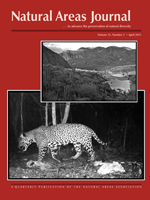Research was conducted on control methods for Oriental bittersweet (Celastrus orbiculatus), pale swallow-wort (Cynanchum rossicum), and Morrow's honeysuckle (Lonicera morrowii) near Long Island Sound in Groton and East Lyme, Connecticut. These nonnative, invasive plants threaten the health of ecosystems at these sites and many other areas throughout the Northeast. For the Oriental bittersweet study, vines were treated at one of three timings (April, August, or November) in 2003 and evaluated in the summer of 2004. Treatments consisted of triclopyr ester formulations applied to the basal bark of uncut vines, or of triclopyr amine or glyphosate formulations applied to the stump surface of cut vines. The experiment was repeated with a different set of vines treated in 2004 and evaluated in 2005. Cut-stump herbicide treatments were generally more effective than basal-bark treatments at killing bittersweet vines. All cut-stump herbicide treatments were effective in reducing vine survival and number and length of sprouts. Pale swallow-wort plots were established in areas of high infestation near the shore. Treatments applied in July 2003, and again in August 2004, included hand pulling, cutting, application of glyphosate or triclopyr amine to cut stems, or foliar sprays of glyphosate or triclopyr amine. By July 2005, glyphosate foliar sprays and cut-stem treatments with glyphosate or triclopyr caused the greatest reduction in the amount of swallow-wort, and the glyphosate treatments were most effective in reducing swallow-wort vigor. Triclopyr foliar sprays injured swallow-wort, but long-term control was not better than that provided by annual hand pulling, cutting, or no treatment. For Morrow's honeysuckle, herbicide treatments were applied to freshly cut stumps in August 2005, and were evaluated in May 2006. Treatments consisted of glyphosate, triclopyr amine, or triclopyr ester, each applied at low or high doses. All triclopyr treatments reduced the number and length of sprouts, and both glyphosate treatments completely prevented sprouting from honeysuckle stumps. Our study provides land managers with effective control methods for three highly invasive plants.
How to translate text using browser tools
1 April 2015
Cutting and Herbicide Treatments for Control of Oriental Bittersweet, Pale Swallow-Wort and Morrow's Honeysuckle
Todd L. Mervosh,
David Gumbart
ACCESS THE FULL ARTICLE

Natural Areas Journal
Vol. 35 • No. 2
April 2015
Vol. 35 • No. 2
April 2015
bittersweet
Celastrus orbiculatus
Cynanchum rossicum
Glyphosate
herbicides
honeysuckle
invasive plants




